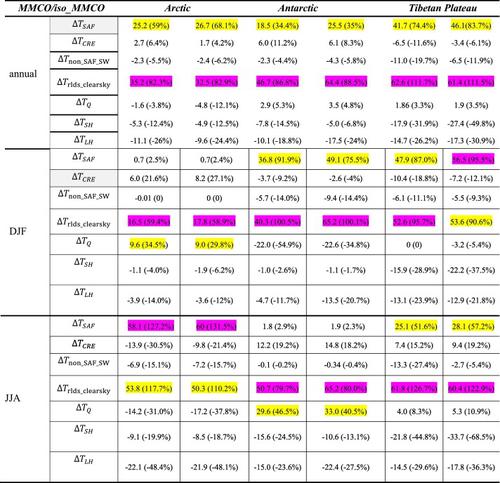当前位置:
X-MOL 学术
›
Palaeogeogr. Palaeoclimatol. Palaeoecol.
›
论文详情
Our official English website, www.x-mol.net, welcomes your feedback! (Note: you will need to create a separate account there.)
Simulating surface warming in Earth's three polar regions during the Middle Miocene Climatic Optimum using isotopic and non-isotopic versions of the Community Earth System Model
Palaeogeography, Palaeoclimatology, Palaeoecology ( IF 3 ) Pub Date : 2024-03-21 , DOI: 10.1016/j.palaeo.2024.112156 Yong Sun , Lin Ding , Baohuang Su , Christian Stepanek , Gilles Ramstein
Palaeogeography, Palaeoclimatology, Palaeoecology ( IF 3 ) Pub Date : 2024-03-21 , DOI: 10.1016/j.palaeo.2024.112156 Yong Sun , Lin Ding , Baohuang Su , Christian Stepanek , Gilles Ramstein

|
The Earth's North and South Poles and the Tibetan Plateau — collectively referred to as the ‘three poles’ — are regions that are very sensitive to climate changes and are known to amplify shifts in global temperature. In the case of the polar regions this effect is well known as polar amplification. The climate patterns during the Middle Miocene Climatic Optimum (MMCO) are considered a past analog to future climate, which could develop patterns and characteristics bearing similarity to MMCO by the end of the century. Therefore, analyzing MMCO environmental conditions in these regions in comparison to a pre-Industrial reference state provides valuable insights into possible future surface temperature changes at the Earth's three poles. We conducted simulations of the MMCO, focusing on surface temperature anomalies at the Earth's three poles. As a modelling tool we employed two versions of the Community Earth System Model (CESM), one of them equipped with model dynamics to simulate stable water isotopes. During the MMCO, we show 1) temperature anomalies at the three poles exceeded global averages, with Antarctica warming most, followed by the Tibetan Plateau and the Arctic, highlighting the role of the Tibetan Plateau as a key factor in global climate change often overlooked; 2) temperature anomalies at the Tibetan Plateau are higher in boreal winter (DJF), while in the Arctic and Antarctic temperature anomalies are larger in boreal summer (JJA), highlighting a seasonal shift between the maximum of climate change signals at the third pole; 3) Changes in clear-sky surface downwelling longwave radiation fluxes () and changes in surface albedo forcing () constitute the primary and secondary mechanisms driving the annual surface temperature anomaly at the Earth's three poles. In contrast, the leading physical processes governing the seasonal cycle are subject to regional variation.
中文翻译:

使用社区地球系统模型的同位素和非同位素版本模拟中中新世气候最佳时期地球三个极地的地表变暖
地球的南北两极以及青藏高原(统称为“三极”)是对气候变化非常敏感的地区,并且众所周知会放大全球气温的变化。在极地区域的情况下,这种效应被称为极地放大。中中新世气候最佳期 (MMCO) 期间的气候模式被认为是过去对未来气候的模拟,到本世纪末可能会形成与 MMCO 相似的模式和特征。因此,将这些地区的 MMCO 环境条件与工业化前的参考状态进行比较分析,可以为了解地球三极未来可能的表面温度变化提供有价值的见解。我们对 MMCO 进行了模拟,重点关注地球三极的表面温度异常。作为建模工具,我们采用了社区地球系统模型 (CESM) 的两个版本,其中一个配备了模型动力学来模拟稳定水同位素。在MMCO期间,我们展示了1)三极气温异常超过全球平均水平,其中南极洲变暖最为严重,其次是青藏高原和北极,凸显了青藏高原作为全球气候变化中经常被忽视的关键因素的作用; 2)青藏高原在北半球冬季(DJF)的温度异常较高,而北极和南极洲在北半球夏季(JJA)的温度异常较大,凸显了第三极气候变化信号最大值之间的季节变化; 3) 晴空表面下降长波辐射通量( )的变化和地表反照率强迫( )的变化构成驱动地球三极年表面温度异常的主要和次要机制。相比之下,控制季节周期的主要物理过程会受到区域差异的影响。
更新日期:2024-03-21
中文翻译:

使用社区地球系统模型的同位素和非同位素版本模拟中中新世气候最佳时期地球三个极地的地表变暖
地球的南北两极以及青藏高原(统称为“三极”)是对气候变化非常敏感的地区,并且众所周知会放大全球气温的变化。在极地区域的情况下,这种效应被称为极地放大。中中新世气候最佳期 (MMCO) 期间的气候模式被认为是过去对未来气候的模拟,到本世纪末可能会形成与 MMCO 相似的模式和特征。因此,将这些地区的 MMCO 环境条件与工业化前的参考状态进行比较分析,可以为了解地球三极未来可能的表面温度变化提供有价值的见解。我们对 MMCO 进行了模拟,重点关注地球三极的表面温度异常。作为建模工具,我们采用了社区地球系统模型 (CESM) 的两个版本,其中一个配备了模型动力学来模拟稳定水同位素。在MMCO期间,我们展示了1)三极气温异常超过全球平均水平,其中南极洲变暖最为严重,其次是青藏高原和北极,凸显了青藏高原作为全球气候变化中经常被忽视的关键因素的作用; 2)青藏高原在北半球冬季(DJF)的温度异常较高,而北极和南极洲在北半球夏季(JJA)的温度异常较大,凸显了第三极气候变化信号最大值之间的季节变化; 3) 晴空表面下降长波辐射通量( )的变化和地表反照率强迫( )的变化构成驱动地球三极年表面温度异常的主要和次要机制。相比之下,控制季节周期的主要物理过程会受到区域差异的影响。



























 京公网安备 11010802027423号
京公网安备 11010802027423号